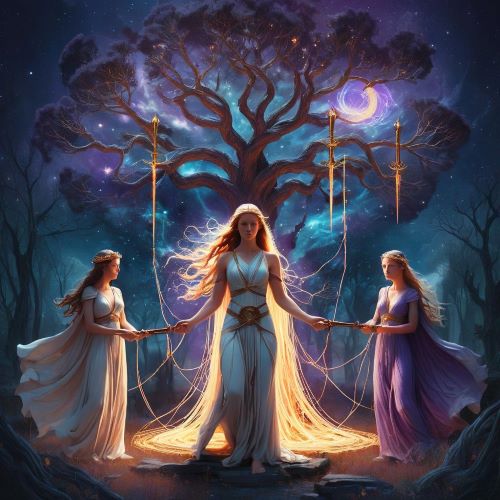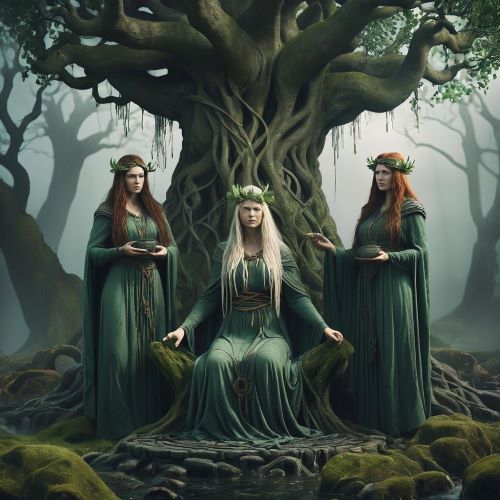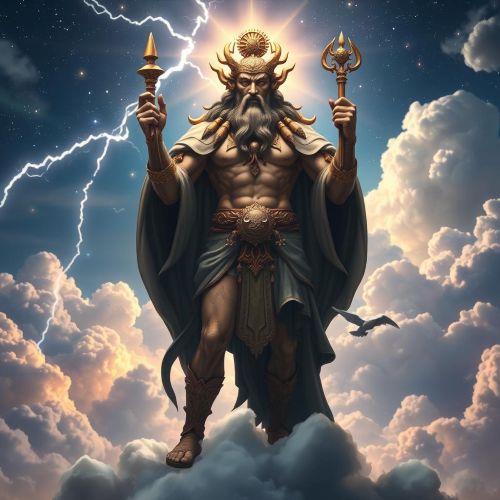Moirai: The Powerful Goddesses Who Controlled Fate in Ancient Greece
In the grand world of Greek mythology, where gods, titans, and mortals struggled for power and destiny, few figures held as much authority as the Moirai. Known as the goddesses of fate, the Moirai were responsible for weaving, measuring, and ultimately cutting the thread of life for every being, mortal and divine. Unlike other gods whose powers could be swayed by prayer or sacrifice, the Moirai embodied an unshakable cosmic law: fate itself. Even Zeus, the mighty ruler of Olympus, could not completely defy their will. This made them some of the most feared and respected figures in the Greek pantheon.
The Origin of the Moirai
The Moirai are often depicted as three sisters: Clotho, Lachesis, and Atropos. Ancient sources vary on their parentage. Some traditions name them daughters of Nyx (Night), the primordial goddess, while others suggest they were born of Zeus and Themis (Divine Law). Regardless of their origins, their presence symbolized inevitability—the reminder that no one could escape destiny, no matter how powerful.
Their name, Moirai, comes from the Greek word moira, meaning “portion” or “lot,” emphasizing their role in assigning each being their share in life and death. This etymology reflects the deep Greek belief that every soul had a destined path, predetermined and immutable.
The Three Sisters of Fate
The Moirai are always described as three distinct figures, each with a specific role in controlling the thread of life:
-
Clotho (The Spinner): She began the thread of life, spinning it from her spindle. Her role symbolized birth and the beginning of existence.
-
Lachesis (The Allotter): She measured the length of the thread, determining how long a mortal’s life would last. She represented the experiences, choices, and fortune one would encounter.
-
Atropos (The Inflexible): The most dreaded of the three, she cut the thread with her shears, ending life. Her decision was final and could not be reversed.
Together, the Moirai maintained balance in the universe by ensuring that each person lived according to their destined share, without excess or deprivation.
The Moirai in Greek Literature and Mythology
The Moirai appear in numerous Greek myths and tragedies, often reminding both gods and humans that fate cannot be avoided. In Homer’s Iliad and Odyssey, references to fate emphasize that even heroes like Achilles and Odysseus could not escape their destined end. Similarly, in Hesiod’s Theogony, the Moirai are shown as eternal forces ensuring the natural order of the cosmos.
One famous example is the myth of Oedipus, where despite every attempt by his parents and himself to alter destiny, he ultimately fulfills the prophecy of killing his father and marrying his mother. This illustrates the Moirai’s absolute power: no act of will could undo what was already woven.
Symbolism and Representation
The Moirai were often portrayed as stern, aged women, representing the inevitability and seriousness of fate. They carried symbolic tools such as the spindle, thread, and shears. In artistic depictions, Clotho is usually shown spinning, Lachesis measuring with a staff or scroll, and Atropos with her shears poised to cut.
Their symbolism extends beyond mythology into philosophy. The Stoics, for instance, embraced the Moirai as representations of natural law and destiny, teaching acceptance of life’s course as part of universal order.
Influence Beyond Greek Mythology
The concept of the Moirai influenced later traditions across Europe. In Roman mythology, they were known as the Parcae or Fata. Similarly, Norse mythology has the Norns, who also weave the destinies of gods and men. This recurring theme across cultures highlights a shared human fascination with destiny and the inevitability of death.
In modern culture, the Moirai continue to inspire literature, films, and even video games. They often symbolize inevitability, the inescapable pull of time, or the limits of human control. From novels exploring free will versus determinism to fantasy role-playing games featuring fate-weaving figures, the Moirai’s legacy remains deeply embedded in storytelling.
Why the Moirai Still Matter
The Moirai endure as powerful reminders of the human condition. They embody the tension between free will and destiny, reminding us that while our choices matter, some things remain beyond control. Their myth underscores a timeless truth: life is a thread, fragile and finite, woven into a greater tapestry of existence.
Whether viewed as supernatural figures or as metaphors for the natural order, the Moirai invite us to reflect on our lives, mortality, and the meaning of fate.
No posts were found.









